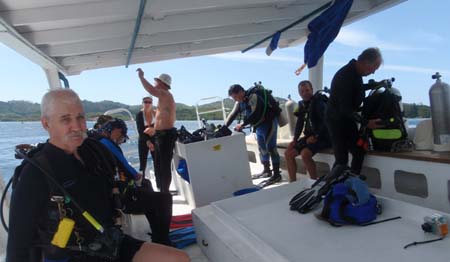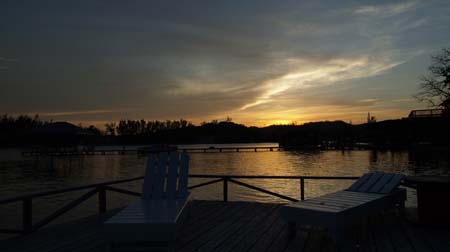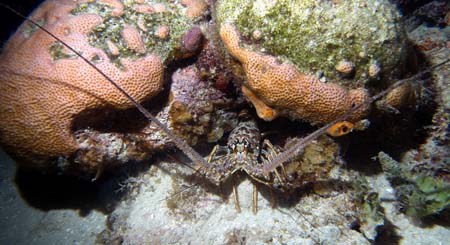« Contemplations on a day off | Main | Mary's Place »
August 27, 2008
Waves, surge, sharks and night dives
Lakes are rarely rough and so my diving before Roatan had been in calm water, all of it. I really did not know what to expect from the sea. I remember long vacations on the beaches of Italy and Western France and how the surf pounded the beach, sometimes so strongly that a flag was up indicating that there would be no swimming that day. The beaches on the Outer Banks of North Carolina, of New England and the West Coast of the United States can all be rough and forbidding. On the other hand, I've seen gentle beaches with crystal-clear water and white sand on Spain's Costa Del Sol in the late 1970s, and I still wish I could have been diving there.

Diving in the sea is different. I learned that it can be as calm underwater as in a lake or spring. And even if there are some waves on the surface, once you go under it's all still. But that's not always the case. On some of the dives the water was pretty rough down there. What is waves on the surface is surge at the bottom. You get buffeted around in a rhythm and it becomes more difficult to move and control where you're going. That can be a problem when you want to get close to something so you can take pictures but also want to make sure you don't bump into it and harm the plants. Several times I found myself entirely too close to a wall with its rich cover of sponges and all sorts of outlandish growth, and was unable to get away from it without the vigorous use of fins that might have harmed the plants. Sometimes surge is obvious as in when you see the plantlife swaying back and forth. Other times you don't see it, but feel that you're just not going where you think your movements should get you.
In addition, there's current. Here again, things can be deceptive. Sometimes it's very noticeable and you just fly away, other times you just marvel how effortlessly and quickly you can swim just to find that it isn't nearly as easy to go the other way. That can be a problem as you don't want to get separated from your buddy or buddies, and certainly not from the dive boat.
As for sharks, I didn't see any nor did I do the shark dive on my trip to Roatan. I felt I just wasn't quite ready as I was still acclimatizing myself to diving in the sea and learning something new with every dive. With the exception of a couple of barracudas and some groupers, all from a distance, I hadn't really seen any big fish, so starting out with a bunch of sharks in a feeding frenzy seemed a bit much. Some guests did go, though, and as I expected, they felt it was an incredible experience.
Brian, a very experienced diver from Tuscaloosa, Alabama, and his girlfriend Joanne, also an experienced diver, did go on the shark dive organized by a couple of Italian divemasters who run Waihuka Diving Adventures. The dive site they boat their daring customers to is called "Cara a Cara" -- Spanish for Face-to-Face. Brian said they went down along a line to about 70 feet where they stood and sat against a cliff. Shark feed operations use chum buckets full of stuff that sharks like and the local sharks know the routine. According to Brian, once the dinner bell is rung, the sharks, Caribbean Reef Sharks, appear in a hurry and do get into the feeding frenzy you see in TV documentaries. However, they have no interest whatsoever in the divers, just the food in the chum bucket. Divers are allowed to circle around the whole scene. Once the chum is gone, the sharks leave. The whole thing is recorded on video and participants can buy a DVD. I saw the DVD and it was stunning.
Maybe next time.

I did do one night dive. I had wanted to do more, but each day I was just too pooped after three or four dives to gear up yet again. Others went every night. For beach dives, the protocol at CoCo View is that a flashing strobe must be attached high above the bottom on the "front yard" buoy mooring chain. The first diver who goes out must take the strobe and attach it. Each subsequent diver then takes a numbered tag that must be clipped onto the chain. That way everyone knows divers are out there. Upon return, the last diver retrieves the strobe and brings it back in.
We went fairly late and everyone else, including the strobe, were already back. So we took it out again. We waded through the shallow part of the beach, then donned our fins and turned the divelights on. I brought two, my little Scubapro and a somewhat stronger backup. We quickly found an octopus and stopped to watch it. That was easier said than done for me as the lack of vision and visual references made hovering difficult. Carol attached the strobe to the mooring chain when we reached it and then we were off hunting for whatever might come out at night. There were, as I quickly noticed, a lot of curious fish, some of them quite large. It was mildly disconcerting to train my lights into the dark and then see shadows gliding in and out of my field of vision. Carol went off exploring with the Olympus Evolt 330 digital SLR and I stayed close, lighting things for her. We saw and photographed some interesting critters. The uneasiness never left me.

But it got worse. We encountered blood worms that swarm the divelights like angry flies. You'd think worms just wiggle around on the ground, but these pests buzzed around lights faster than anything I've ever encountered on land, and they got into things. Fortunately, I wore my 3mm wetsuit, but I still felt them against my hands, face and ears. I pulled my skullcap down over my ears as far as I could. Those things were an absolute pain and ruined whatever enjoyment I might have had out of that night dive. Yuk! We quickly retrieved the strobe and retreated to the beach. I'll try again to see if I can find the night dive magic many divers talk about.
Posted by conradb212 at August 27, 2008 11:32 PM








